- Clone
- 5E8 (See other available formats)
- Regulatory Status
- RUO
- Other Names
- CC CKR3, MIP1-alpha receptor like-2, eotaxin receptor, CD193, CCR3
- Isotype
- Mouse IgG2b, κ
- Ave. Rating
- Submit a Review
- Product Citations
- publications
CD193, also known as CC-chemokine receptor 3 (CCR3), CC CKR3, MIP1-alpha receptor like-2, and eotaxin receptor, is a member of the G protein-coupled seven transmembrane receptors family. It binds to the CC chemokines eotaxin, eotaxin-2, and eotaxin-3 with high affinity. CCR3 has also been reported to bind RANTES, MCP-3, and MCP-4 with low affinity. CCR3 receptor is expressed on human eosinophils, basophils, mast cells, mononuclear phagocytes, platelets, CD34+ hematopoietic progenitor cells, Th2-like lymphocytes, and keratinocytes. CCR3 is thought to play a role in allergic diseases such as bronchial asthma and allergic rhinitis. CCR3 is a co-receptor for HIV-1 and HIV-2, and the binding of eotaxin with CCR3 has been shown to inhibit HIV infection in some cell types.
Product DetailsProduct Details
- Verified Reactivity
- Human
- Antibody Type
- Monoclonal
- Host Species
- Mouse
- Formulation
- Phosphate-buffered solution, pH 7.2, containing 0.09% sodium azide
- Preparation
- The antibody was purified by affinity chromatography and conjugated with Spark Blue™ 550 under optimal conditions.
- Concentration
- 0.2 mg/mL
- Storage & Handling
- The antibody solution should be stored undiluted between 2°C and 8°C, and protected from prolonged exposure to light. Do not freeze.
- Application
-
FC
- Recommended Usage
-
Flexi-Fluors™ are provided at a standard 0.2 mg/mL concentration. We recommend titrating this reagent to determine the optimal concentration for each application. For many flow cytometry applications, conjugated antibodies perform well at concentrations ranging from 0.03 to 1.0 µg per million cells in 100 µL. We recommend testing a range of concentrations starting from 10 µg/mL.
For example, make five 1:1 serial dilutions of the 0.2 mg/mL antibody. Add 5 µL of each dilution (including the undiluted antibody) to 100 µL of cells (at 107 cells/mL) to test six concentrations -- 1.0, 0.5, 0.25, 0.125, 0.06, and 0.03 µg per million cells in 100 µL volume. Compare staining patterns or create a titration curve using the MFI or staining index to determine the optimal concentration.
* Spark Blue™ 550 has a maximum excitation of 516 nm and a maximum emission of 540 nm. - Excitation Laser
-
Blue Laser (488 nm)
- Application Notes
-
Additional reported applications (for the relevant formats) include: The 5E8 antibody is useful for immunofluorescent staining and flow cytometric analysis of CCR3 expression.
It has been observed that the 5E8 antibody clone can interact with PE/Cyanine7 antibody conjugates during multi-color staining, potentially leading to unwanted staining. This interaction can be resolved by sequentially staining with the 5E8 antibody first and then followed by the PE/Cyanine7 conjugate of interest. - Additional Product Notes
-
For more information about Flexi-Fluors™, visit our Flexi-Fluor™ page and review FAQs associated with this product line.
- Application References
-
- Beauvillian C, et al. 2011. Blood 117:1196. PubMed
- RRID
-
AB_3106271 (BioLegend Cat. No. 285003)
Antigen Details
- Structure
- G-protein coupled seven transmembrane domain receptor, 356 amino acids
- Distribution
-
Eosinophils, basophils, mast, mononuclear phagocytes, platelets, CD34+ hematopoietic progenitor, Th2, keratinocytes
- Function
- Co-receptor for HIV-1 and HIV-2, allergy
- Receptors
- Eotaxin, eotaxin-2, eotaxin-3
- Cell Type
- Eosinophils, Erythrocytes, Hematopoietic stem and progenitors, Macrophages, Mast cells, Thymocytes
- Biology Area
- Immunology
- Molecular Family
- CD Molecules, Cytokine/Chemokine Receptors, GPCR
- Antigen References
-
1. Gerard W, et al. 1996. J. Exp. Med. 183:2437.
2. Uguccioni C, et al. 1997. J. Clin. Invest. 100:1137.
3. Sallusto F, et al. 1997. Science. 277:2005.
4. Loetscher P, et al. 2001. J. Biol. Chem. 276:2986. - Regulation
- Upregulated by high affinity Fc IgE receptor ligation (mast cells), RANTES (keratinocytes), IFNg (monocytes, neutrophils), HIV tat protein (basophils), IL-3, IL-5 and GM-CSF (CD34+ progenitor cells), IL-2 and IL-4(T cells). Downregulated by IL-
- Gene ID
- 1232 View all products for this Gene ID
- UniProt
- View information about CD193 on UniProt.org
Related FAQs
- Does staining at room temperature or even at 37°C help for checking chemokine receptors expression?
-
Due to continuous recycling of many chemokine receptors, it may be worthwhile to consider staining at room temperature or at 37°C if the staining at lower temperature (which can potentially reduce receptor turnover) is not optimal.
- What are Flexi-Fluors?
-
Flexi-Fluors are rapidly made-to-order conjugated antibodies. The technology, manufacturing processes, and specifications used to create Flexi-Fluors are the same as our regular catalog products. However, the optimal concentration and performance of each Flexi-Fluor must be determined by the customer.
- How quickly will I receive my order?
-
We aim to ship Flexi-Fluors within 2-3 weeks of receipt of your order. However, depending on your location, shipping times may vary.
- How are Flexi-Fluors different from regular catalog products?
-
Flexi-Fluors are made on demand, specifically for you. Flexi-Fluors are manufactured using the same high-quality standards, and specifications as other catalog products. For faster delivery, Flexi-Fluors are not tested by flow cytometry to determine optimal concentrations or evaluate performance. This testing needs to be performed by the customer.
- How do I determine the optimal concentration for using my Flexi-Fluor? How should I titrate my antibody?
-
Flexi-Fluors are provided at a standard 0.2 mg/mL concentration. We recommend that you titrate your antibody to determine the optimal concentration to use for your application. For many flow cytometry applications, conjugated antibodies perform well at concentrations ranging from 0.03 to 1.0 µg per million cells in 100 µL volume. We recommend that you test a range of concentrations starting from 10 µg/mL.
For example, make five 1:1 serial dilutions of your 0.2 mg/mL antibody. Add 5 µL of each dilution (including the undiluted antibody) to 100 µL of cells (at 107 cells/ml) to test six concentrations - 1.0, 0.5, 0.25, 0.125, 0.06, and 0.03 µg per million cells in 100 µL volume. Compare staining patterns or create a titration curve using the MFI or staining index to determine the optimal concentration.
- I can’t find the antibody-dye combination that I need. When will it be available?
-
We continuously update our catalog, introducing scores of new products every month. Please get in touch with our Technical Service team for an update on new products or recommendations for suitable alternatives to complete your panel. Or contact Custom Solutions to inquire about our affordable custom conjugation services.
- I need help to validate the performance of my Flexi-Fluor. Who should I contact?
-
Please get in touch with Technical Service for assistance.
- Can I order more than 50 μg of a Flexi-Fluor?
-
Yes, you can order multiple vials of the same Flexi-Fluor products. We cannot guarantee, however, that these vials will be bottled from the same lot. For bulk single-lot orders, contact our Custom Solutions team.
- What is the expiration date of my Flexi-Fluor?
-
Expiration dates can be found on the vial label or by using our CoA lookup tool.
Other Formats
View All CD193 Reagents Request Custom ConjugationCompare Data Across All Formats
This data display is provided for general comparisons between formats.
Your actual data may vary due to variations in samples, target cells, instruments and their settings, staining conditions, and other factors.
If you need assistance with selecting the best format contact our expert technical support team.
-
Purified anti-human CD193 (CCR3)
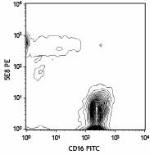
Human peripheral blood granulocytes stained with 5E8 PE and ... 
Human paraffin-embedded skin tissue slices were prepared wit... -
PE anti-human CD193 (CCR3)
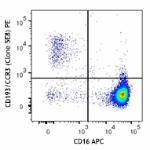
Human peripheral blood leukocytes were stained with CD16 APC... 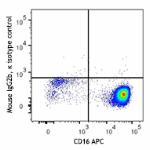
-
Brilliant Violet 605™ anti-human CD193 (CCR3)
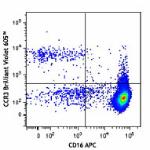
Human peripheral blood leukocytes were stained with CD16 APC... 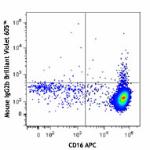
-
APC anti-human CD193 (CCR3)
-
Alexa Fluor® 647 anti-human CD193 (CCR3)
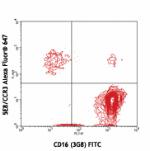
Human peripheral blood granulocytes stained with CD16 FITC a... -
APC/Cyanine7 anti-human CD193 (CCR3)

Human peripheral blood leukocytes were stained with CD16 FIT... -
Brilliant Violet 421™ anti-human CD193 (CCR3)
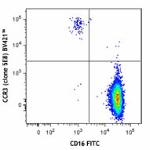
Human peripheral blood leukocytes were stained with CD16 FIT... 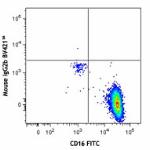
-
PerCP/Cyanine5.5 anti-human CD193 (CCR3)

Human peripheral blood granulocytes were stained with CD16 A... -
FITC anti-human CD193 (CCR3)
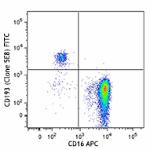
Human peripheral blood leukocytes were stained with CD16 APC... 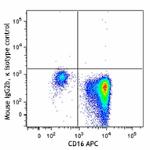
-
Brilliant Violet 510™ anti-human CD193 (CCR3)
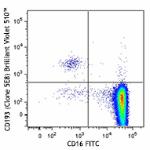
Human peripheral blood leukocytes were stained with CD16 FIT... 
-
Biotin anti-human CD193 (CCR3)
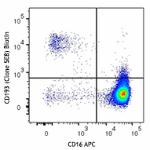
Human peripheral blood leukocytes were stained with CD16 APC... 
-
APC/Fire™ 750 anti-human CD193 (CCR3)
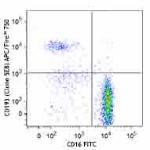
Human peripheral blood leukocytes were stained with CD16 FIT... 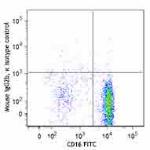
-
PE/Dazzle™ 594 anti-human CD193 (CCR3)
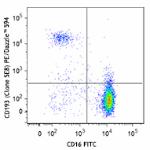
Human peripheral blood leukocytes were stained with CD16 FIT... 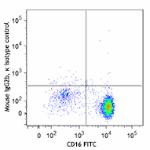
-
TotalSeq™-A0397 anti-human CD193 (CCR3)
-
TotalSeq™-C0397 anti-human CD193 (CCR3)
-
Brilliant Violet 711™ anti-human CD193 (CCR3) Antibody

Human peripheral blood leukocytes were stained with CD16 APC... -
TotalSeq™-D0397 anti-human CD193 (CCR3)
-
TotalSeq™-B0397 anti-human CD193 (CCR3)
-
Spark Blue™ 550 anti-human CD193 (CCR3) (Flexi-Fluor™)
-
Spark Red™ 718 anti-human CD193 (CCR3) (Flexi-Fluor™)

 Login / Register
Login / Register 













Follow Us